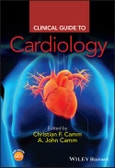Clinical Guide to Cardiology is a quick-reference resource, packed full of bullet points, diagrams, tables and algorithms for the key concepts and facts for important presentations and conditions within cardiology. It provides practical, evidence-based information on interventions, investigations, and the management of clinical cardiology.
Table of Contents
Contributors, viiAcronyms and Abbreviations, viii
About the Companion Website, xiv
PART 1 Examination Techniques, 1
1. Examination Techniques, 3
PART 2 Approach to Presenting Complaints, 11
2. Chest Pain, 13
3. Shortness of Breath, 28
4. Loss of Consciousness, 47
5. Palpitations, 62
6. Cardiac Murmurs, 72
7. Shock, 92
8. Oedema, 106
PART 3 Conditions, 117
9. Acute Coronary Syndrome, 119
10. Stable Angina, 138
11. Heart Failure, 147
12. Infective Endocarditis, 160
13. Arrhythmias, 172
14. Valvular Heart Disease, 193
15. Cardiomyopathy, 214
16. Hypertension, 232
17. Pericardial Disease, 245
18. Congenital Heart Disease, 261
PART 4 Imaging, 277
19. Electrocardiogram, 279
20. Transoesophageal Echocardiogram, 293
21. Trans-Thoracic Echocardiogram, 299
22. Cardiac MRI, 306
23. Cardiac CT, 313
24. Cardiac Catheterization, 320
PART 5 Interventional Therapies, 327
25. Pacemakers and Implantable Cardiac Defibrillators, 329
26. Percutaneous Coronary Intervention and Angioplasty, 338
27. Valvuloplasty, 348
28. Transcatheter Aortic Valve Implantation, 352
29. Cardiac Ablation, 359
PART 6 Pharmacology, 365
30. Anti-Arrhythmic Agents, 367
31. Beta-Blockers, 375
32. Calcium-Channel Blockers, 380
33. Nitrates, 385
34. Drugs Targeting the Angiotensin Axis, 389
35. Diuretics, 393
36. Anticoagulants, 399
37. Antiplatelets, 409
38. Lipid Regulation, 414
Index, 417








